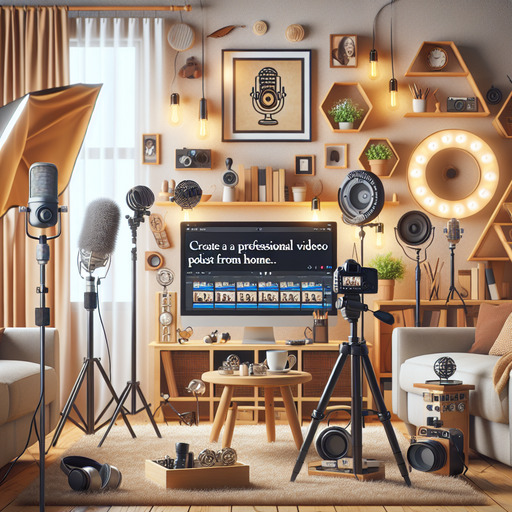
-
Table of Contents
Unlock the secrets to recording a professional video podcast from home! Discover expert tips and techniques to elevate your content. Learn more here.
Introduction
Creating a professional video podcast from home involves several key steps to ensure high-quality production. First, choose a quiet, well-lit space to minimize background noise and ensure good lighting. Invest in essential equipment such as a high-definition camera, a quality microphone, and proper lighting setups like softbox lights or ring lights. Use a tripod to stabilize your camera and consider soundproofing your recording area to enhance audio quality. Plan your content meticulously, including scripting and storyboarding, to maintain a clear and engaging narrative. Familiarize yourself with video editing software to polish your final product, adding elements like intros, outros, and graphics. Finally, test your setup before recording to troubleshoot any technical issues, ensuring a smooth and professional final output.
How to Record a Professional Video Podcast from Home: Essential Tips and Equipment for High-Quality Production
Recording a professional video podcast from home has become increasingly accessible, thanks to advancements in technology and the availability of high-quality equipment. To ensure your video podcast stands out, it is essential to focus on both the technical aspects and the content. By following a few key tips and investing in the right equipment, you can produce a high-quality video podcast that engages and retains your audience.
First and foremost, selecting the right camera is crucial. While many modern smartphones offer impressive video capabilities, investing in a dedicated camera can significantly enhance the quality of your recordings. A DSLR or mirrorless camera with a high-resolution sensor and good low-light performance is ideal. Additionally, ensure that your camera supports external microphones, as audio quality is just as important as video quality.
Speaking of audio, a high-quality microphone is indispensable for a professional video podcast. USB microphones are a popular choice for their ease of use and excellent sound quality. However, for even better results, consider using an XLR microphone with an audio interface. This setup provides superior audio fidelity and greater control over sound levels. Position the microphone close to your mouth, but out of the camera frame, to capture clear and crisp audio.
Lighting is another critical factor in achieving a professional look. Natural light is a great option if you have access to a well-lit room, but it can be inconsistent. To maintain control over your lighting, invest in a set of softbox lights or LED panels. These lights provide even, diffused illumination that reduces harsh shadows and highlights your features. Position the lights at a 45-degree angle on either side of your face to create a balanced and flattering look.
In addition to the technical aspects, the environment in which you record plays a significant role in the overall quality of your video podcast. Choose a quiet, clutter-free space with minimal background noise. Soundproofing your recording area with acoustic panels or foam can further reduce unwanted noise and echoes. Additionally, consider the visual background of your recording space. A clean, professional backdrop or a well-organized bookshelf can add to the aesthetic appeal of your video podcast.
Once you have your equipment and environment set up, it is time to focus on the content. Planning and scripting your episodes can help ensure a smooth and engaging delivery. Outline the main points you want to cover and practice your delivery to maintain a natural and confident tone. Additionally, consider incorporating visual aids, such as slides or graphics, to enhance your presentation and keep your audience engaged.
Editing is the final step in producing a professional video podcast. Use video editing software to trim any unnecessary content, add transitions, and synchronize audio and video tracks. Programs like Adobe Premiere Pro, Final Cut Pro, or even free options like DaVinci Resolve offer powerful editing tools to help you polish your final product. Pay attention to details such as color correction, audio levels, and adding captions or subtitles to make your video podcast accessible to a wider audience.
In conclusion, recording a professional video podcast from home requires careful attention to both technical and content-related aspects. By investing in high-quality equipment, optimizing your recording environment, and meticulously planning and editing your episodes, you can create a video podcast that captivates and retains your audience. With dedication and attention to detail, your home-produced video podcast can achieve a level of professionalism that rivals studio productions.
Q&A
1. **Question:** What equipment do I need to record a professional video podcast from home?
**Answer:** To record a professional video podcast from home, you will need the following equipment:
– A high-quality camera (DSLR, mirrorless, or a high-end webcam)
– A good microphone (USB or XLR)
– Headphones for monitoring audio
– A tripod or camera mount
– Proper lighting (softbox lights, ring light, or natural light)
– A computer with video recording and editing software (such as OBS Studio, Adobe Premiere Pro, or Final Cut Pro)
– Acoustic treatment for your recording space (foam panels, carpets, or curtains)
– A stable internet connection (if streaming or conducting remote interviews)
– Optional: A teleprompter, green screen, and additional accessories like pop filters and shock mounts.